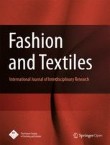Fashion and Textiles is affiliated with The Korean Society of Clothing and Textiles
Cloth face mask fit and function for children part one: design exploration
Commercially available children’s cloth masks range widely in material type and fabric structures, methods of construction, layering, and shape, and there is a lack of sizing systems, anthropometric data or gu...

